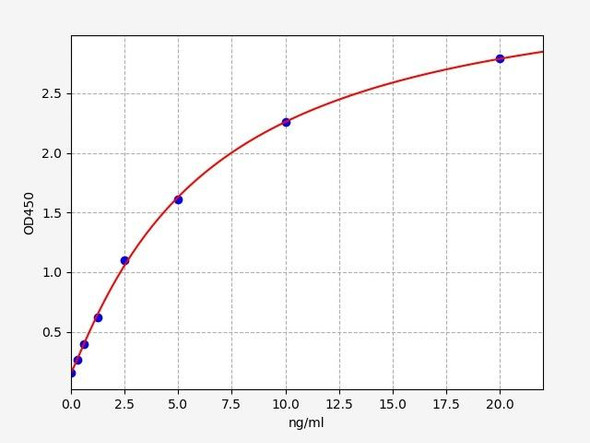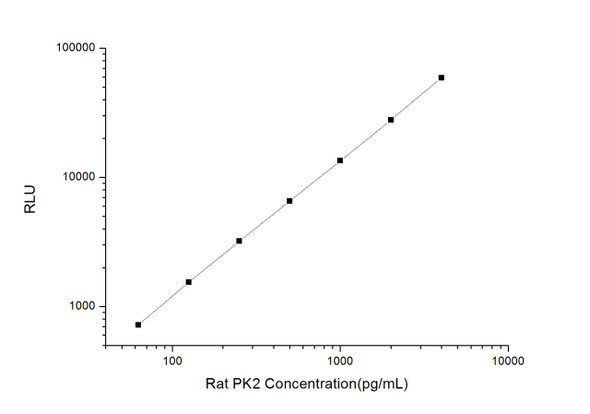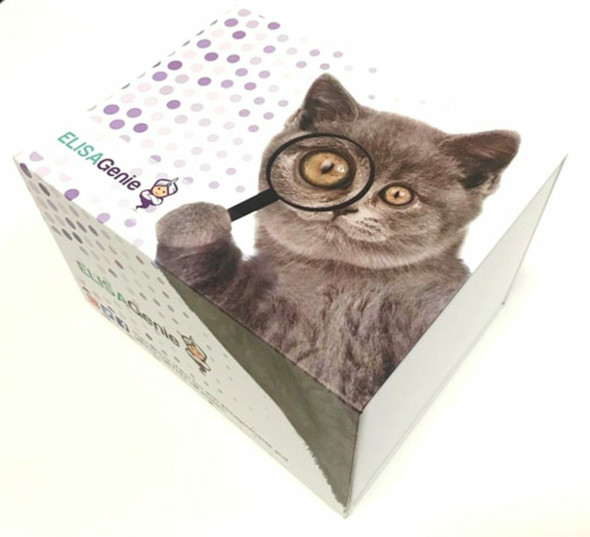Human PK2 (Prokineticin 2) ELISA Kit (HUES02787)
- SKU:
- HUES02787
- Product Type:
- ELISA Kit
- Size:
- 96 Assays
- Uniprot:
- Q9HC23
- Sensitivity:
- 0.19ng/mL
- Range:
- 0.31-20ng/mL
- ELISA Type:
- Sandwich
- Synonyms:
- PROK2, BV8, KAL4, MIT1
- Reactivity:
- Human
- Sample Type:
- Serum, plasma and other biological fluids
- Research Area:
- Cell Biology
Description
Human PK2 (Prokineticin 2) ELISA Kit
The Human PK2 (Prokineticin 2) ELISA Kit is specifically designed for the precise and accurate measurement of prokineticin 2 levels in human samples, including serum, plasma, and cell culture supernatants. This ELISA kit offers outstanding sensitivity and specificity, ensuring dependable and reproducible results for a wide array of research applications.Prokineticin 2, also known as Bv8, is a vital protein involved in various biological processes, including regulation of circadian rhythms, pain perception, and reproductive functions.
Dysregulation of prokineticin 2 has been linked to several health conditions, such as inflammation, cancer, and neurological disorders, making it a crucial biomarker for investigating these diseases and potentially developing new therapies.Overall, the Human PK2 ELISA Kit provides researchers with a powerful tool for studying the role of prokineticin 2 in health and disease, allowing for in-depth analysis and deeper understanding of its physiological functions and potential therapeutic implications.
| Assay type: | Sandwich |
| Format: | 96T |
| Assay time: | 4.5h |
| Reactivity: | Human |
| Detection Method: | Colormetric |
| Detection Range: | 0.31-20 ng/mL |
| Sensitivity: | 0.19 ng/mL |
| Sample Volume Required Per Well: | 100µL |
| Sample Type: | Serum, plasma and other biological fluids |
| Specificity: | This kit recognizes Human PK2 in samples. No significant cross-reactivity or interference between Human PK2 and analogues was observed. |
This ELISA kit uses Sandwich-ELISA as the method. The micro ELISA plate provided in this kit has been pre-coated with an antibody specific to Human PK2. Standards or samples are added to the appropriate micro ELISA plate wells and combined with the specific antibody. Then a biotinylated detection antibody specific for Human PK2 and Avidin-Horseradish Peroxidase (HRP) conjugate are added to each micro plate well successively and incubated. Free components are washed away. The substrate solution is added to each well. Only those wells that contain Human PK2, biotinylated detection antibody and Avidin-HRP conjugate will appear blue in color. The enzyme-substrate reaction is terminated by adding Stop Solution and the color turns yellow. The optical density (OD) is measured spectrophotometrically at a wavelength of 450 nm ± 2 nm. The OD value is proportional to the concentration of Human PK2. The concentration of Human PK2 in samples can be calculated by comparing the OD of the samples to the standard curve.
| UniProt Protein Function: | PROK2: May function as an output molecule from the suprachiasmatic nucleus (SCN) that transmits behavioral circadian rhythm. May also function locally within the SCN to synchronize output. Potently contracts gastrointestinal (GI) smooth muscle. Defects in PROK2 are the cause of Kallmann syndrome type 4 (KAL4); also known as hypogonadotropic hypogonadism and anosmia. Anosmia or hyposmia is related to the absence or hypoplasia of the olfactory bulbs and tracts. Hypogonadism is due to deficiency in gonadotropin-releasing hormone and probably results from a failure of embryonic migration of gonadotropin- releasing hormone-synthesizing neurons. KAL4 patients have variable degrees of olfactory and reproductive dysfunction, but do not show any of the occasional clinical anomalies reported in Kallmann syndrome such as renal agenesis, cleft lip/palate, selective tooth agenesis, and bimanual synkinesis. Belongs to the AVIT (prokineticin) family. 2 isoforms of the human protein are produced by alternative splicing. |
| UniProt Protein Details: | Protein type:Secreted; Secreted, signal peptide Chromosomal Location of Human Ortholog: 3p13 Cellular Component: extracellular region Molecular Function:G-protein-coupled receptor binding Biological Process: circadian rhythm; activation of MAPK activity; sensory perception of pain; chemotaxis; cell proliferation; G-protein coupled receptor protein signaling pathway; elevation of cytosolic calcium ion concentration; neuropeptide signaling pathway; spermatogenesis; angiogenesis; positive regulation of smooth muscle contraction; inflammatory response; negative regulation of apoptosis Disease: Hypogonadotropic Hypogonadism 4 With Or Without Anosmia |
| NCBI Summary: | This gene encodes a protein expressed in the suprachiasmatic nucleus (SCN) circadian clock that may function as the output component of the circadian clock. The secreted form of the encoded protein may also serve as a chemoattractant for neuronal precursor cells in the olfactory bulb. Proteins from other vertebrates which are similar to this gene product were isolated based on homology to snake venom and secretions from frog skin, and have been shown to have diverse functions. Mutations in this gene are associated with Kallmann syndrome 4. Multiple transcript variants encoding different isoforms have been found for this gene. [provided by RefSeq, Jul 2008] |
| UniProt Code: | Q9HC23 |
| NCBI GenInfo Identifier: | 18202953 |
| NCBI Gene ID: | 60675 |
| NCBI Accession: | Q9HC23. 2 |
| UniProt Secondary Accession: | Q9HC23,Q53Z79, Q6ISR0, |
| UniProt Related Accession: | Q9HC23 |
| Molecular Weight: | Calculated MW: 11kDa/14kDaObserved MW: 17kDa |
| NCBI Full Name: | Prokineticin-2 |
| NCBI Synonym Full Names: | prokineticin 2 |
| NCBI Official Symbol: | PROK2 |
| NCBI Official Synonym Symbols: | BV8; HH4; PK2; KAL4; MIT1 |
| NCBI Protein Information: | prokineticin-2; protein Bv8 homolog |
| UniProt Protein Name: | Prokineticin-2 |
| UniProt Synonym Protein Names: | Protein Bv8 homolog |
| Protein Family: | Prokineticin |
| UniProt Gene Name: | PROK2 |
| UniProt Entry Name: | PROK2_HUMAN |
As the OD values of the standard curve may vary according to the conditions of the actual assay performance (e. g. operator, pipetting technique, washing technique or temperature effects), the operator should establish a standard curve for each test. Typical standard curve and data is provided below for reference only.
| Concentration (ng/mL) | O.D | Average | Corrected |
| 20 | 2.471 2.481 | 2.476 | 2.4 |
| 10 | 1.606 1.648 | 1.627 | 1.551 |
| 5 | 0.958 0.95 | 0.954 | 0.878 |
| 2.5 | 0.484 0.492 | 0.488 | 0.412 |
| 1.25 | 0.266 0.266 | 0.266 | 0.19 |
| 0.63 | 0.18 0.176 | 0.178 | 0.102 |
| 0.31 | 0.123 0.133 | 0.128 | 0.052 |
| 0 | 0.071 0.081 | 0.076 | -- |
Precision
Intra-assay Precision (Precision within an assay): 3 samples with low, mid range and high level Human PK2 were tested 20 times on one plate, respectively.
Inter-assay Precision (Precision between assays): 3 samples with low, mid range and high level Human PK2 were tested on 3 different plates, 20 replicates in each plate.
| Intra-assay Precision | Inter-assay Precision | |||||
| Sample | 1 | 2 | 3 | 1 | 2 | 3 |
| n | 20 | 20 | 20 | 20 | 20 | 20 |
| Mean (ng/mL) | 1.04 | 2.48 | 9.58 | 1.00 | 2.31 | 8.94 |
| Standard deviation | 0.06 | 0.12 | 0.37 | 0.07 | 0.11 | 0.47 |
| C V (%) | 5.77 | 4.84 | 3.86 | 7.00 | 4.76 | 5.26 |
Recovery
The recovery of Human PK2 spiked at three different levels in samples throughout the range of the assay was evaluated in various matrices.
| Sample Type | Range (%) | Average Recovery (%) |
| Serum (n=5) | 96-112 | 102 |
| EDTA plasma (n=5) | 90-106 | 97 |
| Cell culture media (n=5) | 87-102 | 94 |
Linearity
Samples were spiked with high concentrations of Human PK2 and diluted with Reference Standard & Sample Diluent to produce samples with values within the range of the assay.
| Serum (n=5) | EDTA plasma (n=5) | Cell culture media (n=5) | ||
| 1:2 | Range (%) | 85-99 | 87-99 | 86-99 |
| Average (%) | 91 | 92 | 93 | |
| 1:4 | Range (%) | 87-103 | 82-93 | 84-96 |
| Average (%) | 94 | 88 | 90 | |
| 1:8 | Range (%) | 91-105 | 83-94 | 89-99 |
| Average (%) | 97 | 88 | 94 | |
| 1:16 | Range (%) | 91-108 | 80-94 | 87-101 |
| Average (%) | 99 | 86 | 93 |
An unopened kit can be stored at 4°C for 1 month. If the kit is not used within 1 month, store the items separately according to the following conditions once the kit is received.
| Item | Specifications | Storage |
| Micro ELISA Plate(Dismountable) | 8 wells ×12 strips | -20°C, 6 months |
| Reference Standard | 2 vials | |
| Concentrated Biotinylated Detection Ab (100×) | 1 vial, 120 µL | |
| Concentrated HRP Conjugate (100×) | 1 vial, 120 µL | -20°C(shading light), 6 months |
| Reference Standard & Sample Diluent | 1 vial, 20 mL | 4°C, 6 months |
| Biotinylated Detection Ab Diluent | 1 vial, 14 mL | |
| HRP Conjugate Diluent | 1 vial, 14 mL | |
| Concentrated Wash Buffer (25×) | 1 vial, 30 mL | |
| Substrate Reagent | 1 vial, 10 mL | 4°C(shading light) |
| Stop Solution | 1 vial, 10 mL | 4°C |
| Plate Sealer | 5 pieces | |
| Product Description | 1 copy | |
| Certificate of Analysis | 1 copy |
- Set standard, test sample and control (zero) wells on the pre-coated plate and record theirpositions. It is recommended to measure each standard and sample in duplicate. Note: addall solutions to the bottom of the plate wells while avoiding contact with the well walls. Ensuresolutions do not foam when adding to the wells.
- Aliquot 100µl of standard solutions into the standard wells.
- Add 100µl of Sample / Standard dilution buffer into the control (zero) well.
- Add 100µl of properly diluted sample (serum, plasma, tissue homogenates and otherbiological fluids) into test sample wells.
- Cover the plate with the sealer provided in the kit and incubate for 90 min at 37°C.
- Aspirate the liquid from each well, do not wash. Immediately add 100µL of BiotinylatedDetection Ab working solution to each well. Cover the plate with a plate seal and gently mix. Incubate for 1 hour at 37°C.
- Aspirate or decant the solution from the plate and add 350µL of wash buffer to each welland incubate for 1-2 minutes at room temperature. Aspirate the solution from each well andclap the plate on absorbent filter paper to dry. Repeat this process 3 times. Note: a microplatewasher can be used in this step and other wash steps.
- Add 100µL of HRP Conjugate working solution to each well. Cover with a plate seal andincubate for 30 min at 37°C.
- Aspirate or decant the solution from each well. Repeat the wash process for five times asconducted in step 7.
- Add 90µL of Substrate Reagent to each well. Cover with a new plate seal and incubate forapproximately 15 min at 37°C. Protect the plate from light. Note: the reaction time can beshortened or extended according to the actual color change, but not by more than 30min.
- Add 50 µL of Stop Solution to each well. Note: Adding the stop solution should be done inthe same order as the substrate solution.
- Determine the optical density (OD value) of each well immediately with a microplate readerset at 450 nm.








